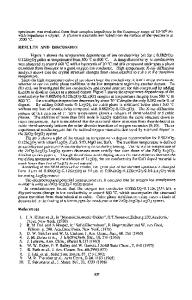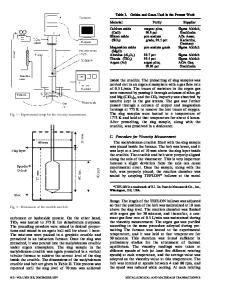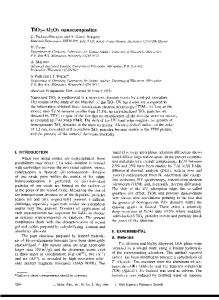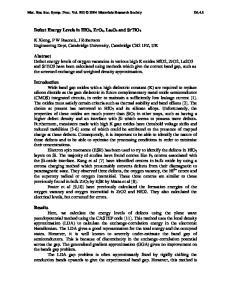Phase transformation and characterization of TiO 2 and ZrO 2 addition in the Li 2 O-Al 2 O 3 -SiO 2 gels
- PDF / 360,943 Bytes
- 5 Pages / 612 x 792 pts (letter) Page_size
- 61 Downloads / 401 Views
MATERIALS RESEARCH
Welcome
Comments
Help
Phase transformation and characterization of TiO2 and ZrO2 addition in the Li2 O–Al2 O3 –SiO2 gels Ming-Hong Lin and Moo-Chin Wang Department of Mechanical Engineering, National Kaohsiung Institute of Technology, 415 Chien-Kung Road, Kaohsiung, 80782, Taiwan, Republic of China (Received 29 April 1995; accepted 1 March 1996)
Glass-ceramic powders with a composition of Li2 O ? Al2 O3 ? 4SiO2 (LAS) have been synthesized by the sol-gel technique using LiOCH3 , Al(OC2 H5 )3 , Si(OC2 H5 )4 , Ti(OC2 H5 )4 , and Zr(OC2 H5 )4 as starting materials and the phase transformation behavior during calcination has been investigated. Differential thermal analysis (DTA), x-ray diffraction (XRD), and scanning electron microscopy (SEM) were utilized to determine the thermal behavior of the gels. Considering the LAS gels with 6.0 wt. % TiO2 and various wt. % ZrO2 content, and peak position of the b-spodumene phase formation in DTA curves was shifted to a higher temperature when the ZrO2 content was increased. The activation energy of b-spodumene crystallization was 283.8 kcalymol for LAS gels with 6.0 wt. % TiO2 and 2.0 wt. % ZrO2 . Unlike foregoing studies for LAS gels, during calcination of the dried LASTZ gels from 800 ±C to 1200 ±C neither b-eucryptite nor g-spodumene was noted to be present. The crystallized phases comprised of b-spodumenes as the major phase and rutile (TiO2 ) together with zirconia (Zr O2 ) are precipitated as minor phases.
I. INTRODUCTION
A group of chemical processes for the production of ceramic and glass materials depends on the preparation and properties of inorganic gels, usually hydrous oxide gels.1 Many of the technical reports describing these processes identify them as sol-gel processes. The use of metal alkoxide to obtain homogenous glasses and ceramics via the sol-gel process has been widely explored for the past several years.2–5 Since this technology allows control of manufacturing processes at micro- and macroscopic scales, the sol-gel method of synthesizing glass or ceramic has many advantages over other methods, such as melt processing or solid-state reaction sintering. Besides the high purity and lower sintering temperature, a high degree of homogeneity on a molecular scale of the product can be obtained via this method.6,7 In a critical review of the structure, properties, and application of glass-ceramics by Beall, TiO2 and ZrO2 have been separately recognized as the nucleating agents in the fabrication of low-expansion Li2 O–Al2 O3 –SiO2 (LAS) glass-ceramics by the conventional meltingcrystallization process.8 However, after two decades a more benevolent process, via LAS powder precursor derived by the sol-gel technique, has been developed.9–13 With respect to the precursor sol-gel technique, the effect of TiO2 as nucleating agent for the b-spodumene crystallization in the LAST system has been evaluated by Orcel and Hench14 and by our prior studies.15–17 Suzuki et al.9 used the partial hydrolysis method of TEOS coupled with the double alkoxide
Data Loading...











